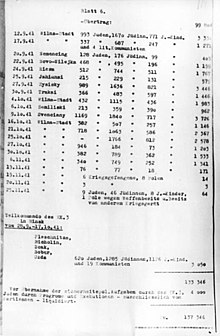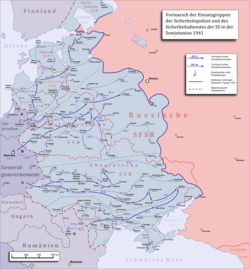The Einsatzgruppen Operational Situation Reports (OSRs), or ERM for the German: Die Ereignismeldung UdSSR (plural: Ereignismeldungen), were dispatches of the Nazi death squads (Einsatzgruppen), which documented the progress of the Holocaust behind the German–Soviet frontier in the course of Operation Barbarossa, during World War II. The extant reports were sent between June 1941 and April 1942 to the Chief of the Security Police and the SD (German: Chef des Sicherheitspolizei und SD) in Berlin, from the occupied eastern territories including modern-day Poland, Belarus, Ukraine, Russia, Moldova, and the Baltic Countries. During the Nuremberg War Crimes Trials the originals were grouped according to year and month and catalogued using a consecutive numbering system, as listed in the below table. The original photostats are held at the National Archives in Washington D.C.[1][2]
| Einsatzgruppen reports | |
|---|---|
Map of the Einsatzgruppen operations with the location of the first shooting of Jewish women and children (along with the men), July 30, 1941.
 The Jäger Report, December 1, 1941. The Jäger Report, December 1, 1941. | |
| Incident type | The Einsatzgruppen shootings |
| Organizations | Schutzstaffel (SS) |
Background
Following the onset of Operation Barbarossa, during the first 5 weeks of their shooting actions, the Einsatzgruppen squads targeted primarily male Jews. This changed on July 29, 1941, when Reinhard Heydrich himself, quoted at an SS meeting in Vileyka (Polish Wilejka), criticized their leaders for the low execution figures. It was therefore ordered that the Jewish women and children be included in all subsequent shooting operations. The first women and children were killed along with the men on July 30, 1941, in Vileyka.[3]
The Nazi Einsatzgruppen were not the only formation tasked with the mass killings. Other formations included the Order Police battalions from Germany (Orpo) participating equally in the mass murder of Polish and Soviet Jews regardless of their age and sex,[4] including in the territories of the formerly Soviet-occupied Poland (see the Red Friday massacre), the Baltic states, and in the USSR proper.[5] Significant numbers of women and children were murdered behind all front lines not only by the Germans but also by the local Ukrainian and Lithuanian auxiliary forces.[6] The largest mass shooting of Soviet Jews took place on September 29, 1941, in the ravine of Babi Yar near Kiev, where 33,771 Jews of all ages were machine-gunned (Situation Report No. 101).[7]
Original German cables
After World War II, the reports were grouped and numbered by the Allies in order to summarize their content. The actual German cables were sent in their own differing sequence including by the Einsatzgruppe A (EG–A) attached to Army Group North, Einsatzgruppe B (EG–B) attached to Army Group Center, Einsatzgruppe C (EG-C) attached to the Army Group South, and Einsatzgruppe D (EG–D) attached to the 11th Army.[8] In the OSRs, individual Ereignismeldungen UdSSR (morning reports) abbr. EM, from EG–A appear in 103 different places. The reports from EG–B appear in 64 OCRs (as arranged by the Allies). The EG-C reports are listed in 77 different OCRs, and the reports from EG–D (with the least representation at source) are featured in 63 OCRs. Occasionally, large gaps appear between individual reports, caused by the lack of time or other complications including broken telephone lines in the East.[9] Notably, in Operational Situation Report number 19, Einsatzgruppe C was changed to Einsatzgruppe B and vice versa, thus confusing further reports of their shooting actions.[8]
The OSRs are far from being equal. Some of them, such as OSR 156, include translated cables from several cities and weeks of shooting actions not yet concluded with tens of thousands of victims mentioned;[10] while other Operational Situation Reports, such as OSR 67, resemble long essays describing mere investigations into partisan activities in rural countryside resulting in dozens of executions.[11] Notably, the reports do not include all killings before the end of 1942.[9]
The following selection of reports are available in English translation.[12] The complete set of reports is available in German.[13][14]
| Operational Situation Report (OSR) with dates: [Shootings] |
|---|
|
See also
- Einsatzgruppen
- Einsatzkommando
- Gerstein Report, 1945
- Höfle Telegram, 1943
- Jäger Report, 1941
- Katzmann Report, 1943
- Korherr Report, 1943
- Riegner Telegram, 1942
- Special Prosecution Book-Poland, 1937–1939
- Bibliography of the Holocaust § Primary Sources
Notes
- ^ a b Holocaust Education & Archive Research Team. "Index". Einsatzgruppen Operational Situation Reports. HolocaustResearchProject.org.
- ^ Yitzhak Arad, with Shmuel Krakowski and Shmuel Spector (1989), The Einsatzgruppen reports: selections from the dispatches of the Nazi Death Squads’ campaign against the Jews July 1941-January 1943, New York, N.Y.: Holocaust Library. Edition details.
- ^ a b Kay, Alex J. (2016). The Making of an SS Killer. Cambridge University Press. pp. 57, 72. ISBN 978-1107146341.
- ^ Browning (2004), p. 232.
- ^ Browning (1998), p. 11: On the eve of Operation Barbarossa Major Weiss disclosed to his men the directives of Hitler's 'Barbarossa Decree'.
- ^ Browning (2004), p. 261.
- ^ Laqueur & Baumel (2001), p. 51.
- ^ a b Yitzhak Arad (2009). The Holocaust in the Soviet Union. University of Nebraska Press. p. 126. ISBN 978-0803222700. Retrieved 25 March 2015.
- ^ a b Ronald Headland (1992). Messages of Murder: A Study of the Reports of the Einsatzgruppen of the Security Police and the Security Service, 1941-1943. Fairleigh Dickinson Univ Press. pp. 27, 92, 98–101, 146. ISBN 0838634184. Archived from the original on 2016-02-16. Retrieved 2016-01-30.
{{cite book}}:|work=ignored (help) - ^ H.E.A.R.T (2008). "Einsatzgruppen Operational Situation Reports #156". Translated by Hermann Feuer. HolocaustResearchProject.org.
- ^ H.E.A.R.T (2008). "Einsatzgruppen Operational Situation Reports #67". Translated by Hermann Feuer. HolocaustResearchProject.org.
- ^ Arad, Yitzhak; Krakowski, Shmuel; Spector, Shmuel; Schossberger, Stella (1989). The Einsatzgruppen reports: Selections from the dispatches of the Nazi Death Squads' campaign against the Jews July 1941-January 1943. Holocaust Library. ISBN 0896040577.
- ^ "Die "Ereignismeldungen UdSSR" 1941".
- ^ https://d-nb.info/1011163101/04 [bare URL PDF]
- ^ H.E.A.R.T (2007), Operational Situation Report No. 10. NARA.
- ^ H.E.A.R.T (2007), Operational Situation Report No. 101. NARA.
- ^ H.E.A.R.T (2007), Operational Situation Report No. 106. NARA.
- ^ Ken Lewis (December 30, 1997). "Summary of Operational Situation Reports: Shootings". Table of Contents : Einsatzgruppe A, B, C and D. The Einsatzgruppen Archives.com. Archived from the original on December 6, 2003 – via Internet Archive.
References
- Browning, Christopher R. (1998). Ordinary men: Reserve Police Battalion 101 and the final solution in Poland (PDF). New York: HarperCollins. ISBN 9780060995065. OCLC 847404688.
- Browning, Christopher R. (2004). The Origins of the Final Solution : The Evolution of Nazi Jewish Policy, September 1939 – March 1942. Comprehensive History of the Holocaust. With contributions by Jürgen Matthäus. London: Random House / William Heinemann. ISBN 0803203926. Newer edition by Univ. of Nebraska Press / Yad Vashem 2007.
- Headland, Ronald (1992). Messages of murder: a study of the reports of the Security Police and the Security Service. Associated University Presses. ISBN 0838634184.
- Laqueur, Walter; Baumel, Judith Tydor (2001). The Holocaust Encyclopedia. New Haven and London: Yale University Press. ISBN 978-0-30008-432-0.
